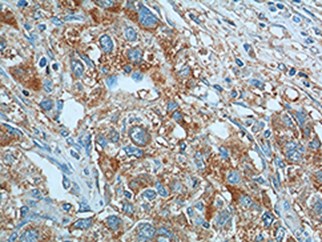I Just Want Your Extra Time And Your...KISS-1
Anti-KISS-1 rabbit polyclonal antibody
By Sophie Quick
The KISS-1 gene may encode a protein relating to cancer research, but the origins of its name could be considered romantic.
KISS-1 is a G-protein coupled receptor ligand for GPR54 and has been used extensively in cancer research. Proteintech’s KISS-1 (18375-1-AP) antibody recognizes all cleaved peptides of KISS-1 and has been tested in ELISA, WB and IHC. KISS-1 can be cleaved into peptides such as metastin (54aa), kisspeptin-14, kisspeptin-13 and kisspeptin-10 and acts as a metastasis suppressor protein in malignant melanomas and in some breast cancers. Kisspeptin-GPR54 signaling also has an important role in initiating secretion of gonadotropin-releasing hormone (GnRH) throughout puberty, the extent of which is an area of ongoing research.
| KISS1 |
 |
| IHC of paraffin embedded human liver cancer tissue slide using 18375-1-AP (KISS1 antibody) at dilution of 1:200 (under 40x lens). |
Believe it or not, the KISS-1 gene was named for the location of its discovery: the lab was just around the corner from the Hershey’s Kisses chocolate factory in Pennsylvania – trivia you could share with your sweetheart this Valentine’s day as you hand over the confectionery*.
If they want to know more about KISS-1, it was first identified in skin cancer cells in 1996; the team described it as a metastasis-suppressor gene, meaning it is able to stop cancer cells spreading to other tissues – admittedly, not so romantic. However, recent discoveries have also identified a role for KISS-1’s protein product in puberty and reproduction…So it may not be incongruously named after all!
First though, let’s give credit to this molecule’s therapeutic potential and review its preventative role in cancer metastasis. Metastasis, the movement of cancer cells from one organ to another, is a complex process that involves cancer cells becoming less adhesive, invading surrounding tissue and moving around the body in the lymphatic or circulatory system. It is thought that the protein that KISS-1 produces, kisspeptin, suppresses metastasis through regulation of cell adhesion, possibly through reorganization of the cells internal structure: the cytoskeleton. The production of kisspeptin is an endogenous tactic to reduce the invasiveness of a tumor, initiating a signal that has since been seen at work in a number of cancers.
A wealth of research carried out in a range of cell lines and patient tissue samples of various types of cancer support this role for KISS-1. In vitro experiments with breast cancer cell lines showed that the loss of the KISS-1 gene led to the increased expression of metastasis-associated transcription factors (1). In pancreatic cancer tissues, lower levels of KISS-1 mRNA were seen compared with normal pancreatic tissues, suggesting that KISS-1 may be an inhibitor of metastasis here as well (2). In gastric cancer it has even been suggested that KISS-1 could be a possible independent predictor of patient survival (3).
The long peptide protein product kisspeptin can be processed and cleaved into four shorter peptides that are all able to stimulate the kisspeptin receptor. One of these shorter peptides, kisspeptin-54, acts on a G-protein coupled receptor on certain neurons in the brain, causing a signaling cascade within the neuron that leads to the secretion of gonadotropin-releasing hormone (GnRH). The production of this hormone is only activated during puberty and goes on to stimulate the release of gonadotropins and sex steroid hormones.
This recently-discovered function of the KISS-1 gene has implicated it as a key regulator in the initiation of the tumultuous period of puberty. A landmark paper in 2013 (4) looked at the KISS-1 gene and the gene for its receptor, KISS-1-R, before, during and after puberty in animals and humans. They saw that the way the genes were annotated, or methylated, changed through these time periods. This affected the types of molecules that could bind to the genes and so affected their expression. During puberty, KISS-1 is upregulated, which seems strangely serendipitous – teenagers hoping for their first kiss can be told they already have had it… albeit as part of their genome expression.
Even more recently, KISS-1 has also been implicated in human reproductive health and disease (5) due to its links with ovulation. It is suggested that manipulating kisspeptin signaling could stimulate the release of these reproductive hormones more naturally than current methods.
So from cancer-relevant target to reproductive hormone modifier, KISS-1 is certainly growing into its name. (As the saying goes: If the shoe fits…!) Perhaps the story of KISS-1 will impress your Valentine this February 14, though it's more likely the Hershey’s version might go down a little better!
*Disclaimer: The author does not accept responsibility for any moods killed by KISS-1-related facts.
Guest blogger profile
| Sophie Quick is a Biology undergraduate at the University of York. Following spending a year in industry at AstraZeneca (AZ), she is completing her final year, currently building a cell line model of bone disease using gene knockout technology. During her AZ placement year she developed 3D cell culture methods for use in high-throughput screening. Currently cultivating a love of science communication as well as research, she plans to continue on to a PhD to pursue her interests in stem cell biology and regenerative medicine. Her main hobby is making science-themed baked goods… and eating them. Suggestions welcome: @SophieFQuick |  |
References
(1) Mitchell DC, Stafford LJ, Li D, Bar-Eli M and Liu M: Transcriptional regulation of KiSS-1 gene expression in metastatic melanoma by specificity protein-1 and its coactivator DRIP-130. Oncogene. 26:1739–1747. 2007.
(2) Liang S and Yang ZL: Expression of KiSS-1 mRNA in pancreatic ductal adenocarcinoma and non-cancerous pancreatic tissues in SD rats. Zhong Nan Da Xue Xue Bao Yi Xue Ban. 32:109–113. 2007.(In Chinese).
(3) Dhar DK, Naora H, Kubota H, et al: Downregulation of KiSS-1 expression is responsible for tumor invasion and worse prognosis in gastric carcinoma. Int J Cancer. 111:868–872. 2004.
(4) Skorupskaite, K., George, J. T., & Anderson, R. A. (2014). The kisspeptin-GnRH pathway in human reproductive health and disease. Human Reproduction Update, 20(4), 485–500. doi:10.1093/humupd/dmu009


